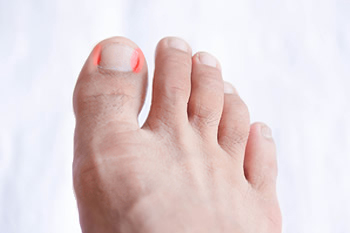
An ingrown toenail develops when the edge of the nail grows into the surrounding skin instead of over it. This often causes tenderness, swelling, and redness along one or both sides of the nail, most commonly on the big toe. In the early stages, the area may feel sore when pressure is applied, especially while wearing shoes. As it progresses, the skin may become inflamed or even show signs of infection such as warmth, pus, or increased pain. Trimming nails too short or at an angle, wearing tight footwear, or stubbing the toe can contribute to the problem. Left untreated, an ingrown toenail may worsen and lead to further complications. If you notice ongoing pain, swelling, or signs of infection near the edge of your toenail, it is suggested that you see a podiatrist to receive proper care and avoid further irritation.
Ingrown toenails can become painful if they are not treated properly. For more information about ingrown toenails, contact Pedram Aslmand, DPM of Advanced Foot and Ankle Center. Our podiatrist can provide the care you need to keep you pain-free and on your feet.
Ingrown Toenails
Ingrown toenails occur when a toenail grows sideways into the bed of the nail, causing pain, swelling, and possibly infection.
Causes
- Bacterial infections
- Improper nail cutting such as cutting it too short or not straight across
- Trauma to the toe, such as stubbing, which causes the nail to grow back irregularly
- Ill-fitting shoes that bunch the toes too close together
- Genetic predisposition
Prevention
Because ingrown toenails are not something found outside of shoe-wearing cultures, going barefoot as often as possible will decrease the likeliness of developing ingrown toenails. Wearing proper fitting shoes and using proper cutting techniques will also help decrease your risk of developing ingrown toenails.
Treatment
Ingrown toenails are a very treatable foot condition. In minor cases, soaking the affected area in salt or antibacterial soaps will not only help with the ingrown nail itself, but also help prevent any infections from occurring. In more severe cases, surgery is an option. In either case, speaking to your podiatrist about this condition will help you get a better understanding of specific treatment options that are right for you.
If you have any questions, please feel free to contact our offices located in Long Beach, CA . We offer the newest diagnostic and treatment technologies for all your foot care needs.

